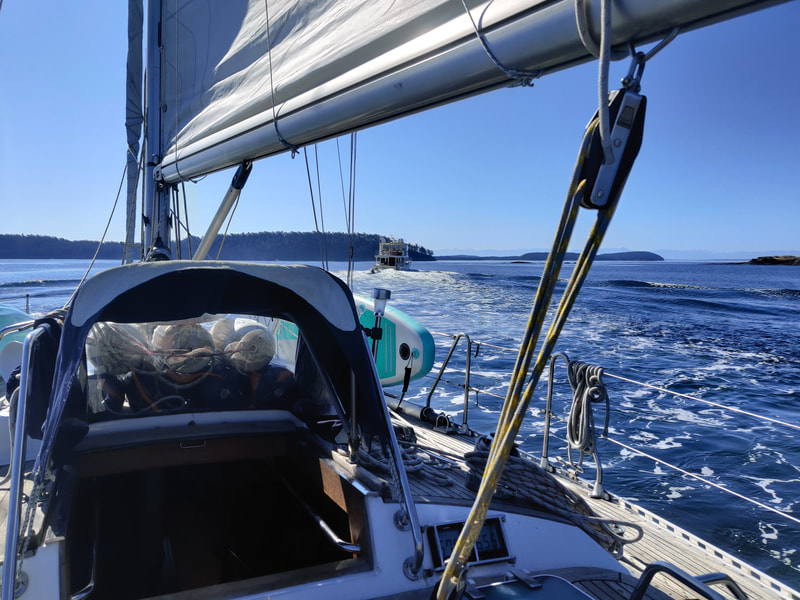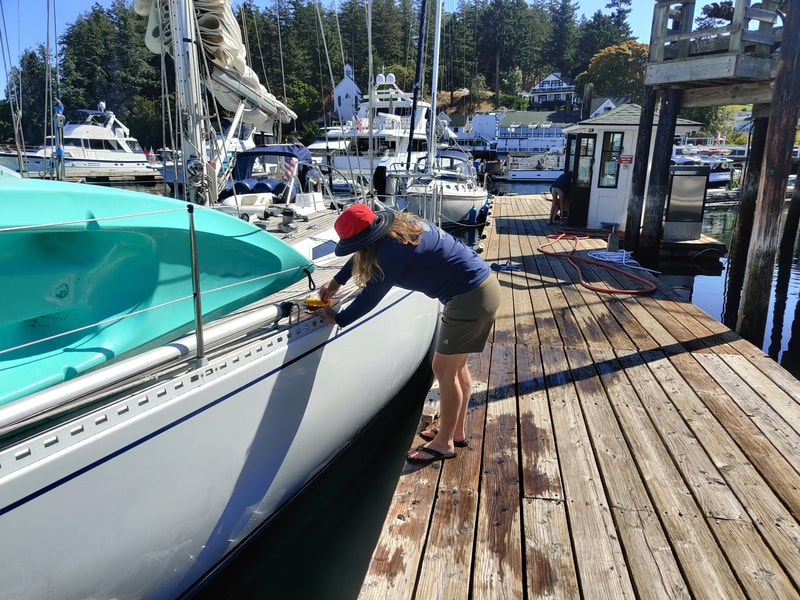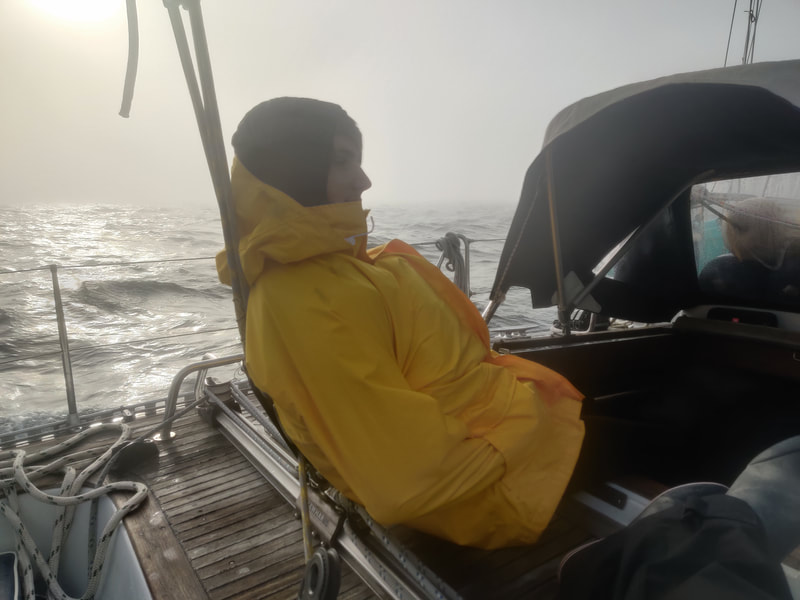|
In Part One we departed Port Angeles to explore the recently opened Canadian waters that had been closed due to Covid. A week later it was time to head back to the states and close our circuitous venture. The nearest port of entry/US customs was located in Roche Harbor on San Juan Island. We were in no hurry. Roche lay only ten nautical miles south of Bedwell/Beaumont Park, our last stop in Canada's Gulf Islands. After breakfast, Loren paddled back to the beach to pick up where he left off exploring the previous day. Erika was back on her reader. I sat in the cockpit watching a couple of combative river otters on the swim dock. I have to say it was quite a match-up. The 10 X 10 swim dock acted like a wrestling ring on the water with me as the only spectator. Their playful quarrel was full of rolling acrobatics, more graceful than scrappy. At one point otter A actually shoved otter B right off the dock. It didn't stop B, presumably the underdog, shooting out of the water like a guided missile and back into the ring. Siblings, brothers, probably. Erika and I don't know anything about that (sarcasm). Beaumont Isl. National Park - Loren fueling up - The Wrestling Ring By late morning we cast off the mooring ball and bid Bedwell adieu. The weather was amazing. Our leisurely sail south across Boundary Pass was both pleasant and quite appropriate, Here we officially concluded our time in Canada and crossed back into US waters. Next stop, US Customs. We charted our passage to Roche via Johns Pass. Resa has cruised to Stuart Island in the recent past. We participated in PAYC's flotilla at Reid Harbor and again at a later date, by ourselves in Prevost Harbor. Both anchorages and hiking highly recommended. Alth0ugh watch for that hidden reef at the entrance to Satellite cove (pic). I witnessed a hard grounding by a small sailboat at that spot. The boat was motoring at an average clip then suddenly stopped, it's mast lurching forward with a rude, abrupt shudder. An uneasy feeling to see and experience to say the least. The boat eventually backed up and anchored in safer waters without any apparent damage. But I'm sure both the keel and the passenger's nerves were a bit mucked-up. Heading to Roche, we cut into Johns Pass, a narrow gap between Stuart and Johns Island. At the tightest section of the pass a large power boat squeezed by us, leaving a large wake... and us behind it. It was definitely in a rush which became obvious when it began to cut the corner south of the pass at full speed, est. about 12 knots. We assumed the captain had local knowledge with regards to the reefs depth and location and I actually reconsidered our original plan to pass far to leeward of the underwater ridge. Not a moment later we watched when the 60 footer threw it's gears in reverse, creating a large froth of churned up seawater astern. It's pilot house lurching forward as the hull came to a stop. But this time, as far as we could discern, there was no contact with the reef. We think the captain "woke up" just in time to read their rapidly decreasing depth instruments and panicked, I imagne. They promptly turned to port, steering around the hazard and continued west. It was obviously not their best moment but its really just another day messing about on boats. Love it or not. Careful when cutting corners when cruising the islands. -Johns Pass' Narrow Cut - The yacht that said "oops" (background) - Spieden Island As Resa left John Island astern the wind disappeared completely so down went the mainsail. The last three or four miles would be a motor ride across the now glassy Spieden Channel. To our port lay Spieden Island. Privately owned, Spieden is unpopulated by humans. I would recommend you get in for a closer look, or pull out the binos, and enjoy viewing its population of exotic sheep, deer and probably a group of Steller sea lions basking in the sun on the south facing side, but watch for the charted reefs, rocks and islets along the west end. Loren Chill'n in the Cockpit Erika working on the CBP app. Ugh, broken pump Plan A was to check back into the states using the mobile passport control app or CBP and use the waste pump-out facility at Roche. Erika began our check in process via the app but ran into issues. She called the Roche customs office and they suggested, since we were here anyways, just re-enter in person. So now we had two reasons to pull into the local marina. So, as I mentioned previously, there were no pump-out stations available along our route. Again, Canada has a relaxed poop (pun intended) policy regarding waste management. This quote from a Canadian government website sums it up, "In Canada, it is illegal to dump sewage from boats within three nautical miles of shore (unless pump-outs are not available, and you cannot get three miles off shore)." Basically it states we could legally dump our waste anywhere along our Gulf Island loop. But we chose not to and our tank was just about to burst, hence our perfect timing to use Roche's facility. The marina was uncomfortably busy so back to Westcott Bay for the night, just a tootle down Mosquito Pass, to officially close the loop. Our hook was set by one o'clock. By three we were hiking the Bell Pt. perimeter trail near English Camp. By four o'clock, Loren and I were exploring Westcott Bay aboard the kayak and SUP while Erika relaxed in the cockpit with her reader. I wanted to check out Westcott Bay Shellfish Co. since we've been hearing how trendy it has become but a raft of harbor seals nearby caught our, okay, my attention instead. Loren and I had a really nice paddle around the bay until sunset. Bell Pt. Trail Relaxing on Resa Paddle Time Sunset in Westcott Bay - Sept. 2, 2021 The next morning we woke up really early to catch an ebb tide down Haro Strait. On the bright side we watched the sun rise and by 6am Resa was free from the bottom and heading home. The day was expected to warm and the wind blow. With sails full Resa blasted down Haro at over 9 knots. We were making great time but the sunshine didn't last. As we approached Juan de Fuca we also approached a wall of thick white fog. We triggered the radar and running lights to see and be seen in the dense cloud. The almost total lack of visibility lasted until we pulled into Port Angeles harbor. The abrupt ending of fog revealed a beautiful sunny blue sky, a first-rate meteorological welcome back home for sure. Maybe 30 feet Visibility Loren on Fog Watch Home again The wall of fog we left outside Port Angeles
0 Comments
Leave a Reply. |
AuthorA UCSC graduate in Marine Biology, Keith holds a 100 ton USCG Capt. License and is an ASA/US sailing certified instructor. Archives
March 2022
Categories |




















 RSS Feed
RSS Feed